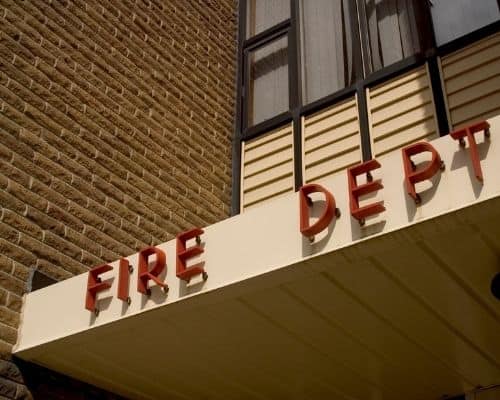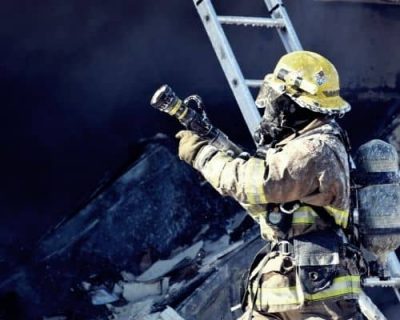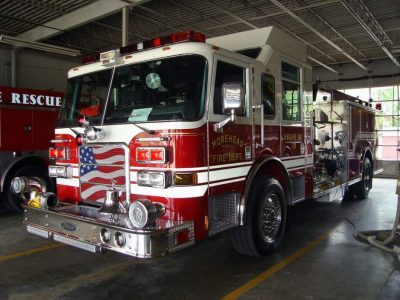All fire departments are subjected to a rating from the Insurance Services Office or ISO. This rating is appropriately called your ISO score. What exactly is an ISO rating and why is a good score important?
A fire department’s ISO rating is a determination by the Insurance Services Office by how well your department is able to serve the community. You’re assigned a score between 1 and 10, with lower numbers indicating a better score. High ISO scores can increase home insurance rates in the community.

In this informative guide, we’ll tell you everything you need to know about your fire department’s ISO score, including the criteria you’re scored on, how to make sense of your score, what the ramifications of a high score are, and if you can do anything to better your ISO rating.
Table of Contents
What Is an ISO Rating? Why Does a High ISO Rating Matter?
As we touched on, the ISO stands for the Insurance Services Office. Although you know the ISO best for its fire ratings, that’s not all this organization does. The ISO also provides claims resolutions and compliance related to Medicare, deals in worker’s comp, provides insurance products, offers insurance line services, and keeps current building code information.
All fire departments are subjected to an ISO rating. The official name for this rating is the Public Protection Classification or PPC, but it’s informally called a fire score. The PPC score is a rating of how efficiently your fire department serves your local community.
Why does your PPC score matter? For several reasons, so let’s talk about them now.
Lower Insurance Rates for Residents
The safer the community is, the lower the home insurance rates are for the people that occupy your city or town. After all, a good ISO score indicates that a fire is not likely to severely damage or even decimate a building since your fire department is on top of it. You don’t need to pay for something that’s probably not going to happen.
Higher PPC scores indicate that a city or town could be ravaged by fire due to the lack of ability, skill, equipment, or even fast response times from the local fire department. For these cities and towns, their home insurance is higher since they need protection if a fire does break out.
In some instances, it’s not quite as cut and dried as that. Insurers can also determine whether a higher or lower ISO score impacts home insurance and by exactly how much. Thus, by shopping around, a homeowner in a city or town with a high ISO score could potentially find slightly lower home insurance rates by going through a different insurer.
This does not mean that insurers will turn a blind eye to a high ISO score though. It simply means that one insurer might deem that a high ISO score means your home insurance goes up by $400 versus once that increases your home insurance by $175.
Proof of Efficiency for Firefighters
If you worked a traditional nine-to-five job, you’d get an annual performance review by your boss or manager that indicates how well you’re doing. The performance review might encompass areas such as your tardiness, rate of assignments completed, number of metrics achieved, and customer satisfaction.

For firefighters, the ISO score is like your manager’s performance review. As we’ll talk about more in the next section, how well you do on the job is included in your overall PPC score.
Just like Zagat ratings and restaurant cleanliness certificates inspire people to eat at certain establishments, a low ISO score will inspire your community to trust in your services should they ever need them.
It’s true that unlike ordering at a restaurant, when a person calls 911, they don’t choose the fire department, but that doesn’t mean that your level of service to the community should ever waver. When citizens feel like they can rely on you, it’s one less thing to worry about in their very busy day-to-day lives.
ISO Rating Scale – What Does It Mean?
As we said in the intro, the ISO rating is a score between one and 10. The higher the score, the worse the fire department is doing in keeping its city or town safe. The best score that you can obtain is one.
To determine what your score is, the ISO (the organization) uses a Fire Suppression Rating Schedule or FSRS. On the FSRS are four sets of criteria that your fire department must meet to get a low score.
The ISO rating scale is from zero to 105.5. Here are the areas that you’re scored on.
Community Risk Reduction
The Community Risk Reduction section can account for up to 5.5 points, so it’s not much. That’s because this is considered an extra section.
This category is all about how well you’re keeping your community safe both when you’re on the job and off. If your fire department offers fire safety and prevention courses or you do community outreach, then you’re likely to lower your Community Risk Reduction score. That’s also true if you launch fire investigations through the National Fire Incident Reporting System.
Water Supply
Your Water Supply score can add up to 40 points to your overall PPC score, so it’s one area that you must pay attention to.
How much water your fire department has available to put out fires at any time is a big scoring criterion.
Is your city or town full of fire hydrants? The more hydrants you have, the lower your score. A lack of fire hydrants will increase the Water Supply score. If your fire hydrants have never been inspected though, that can cause your ISO score to go back up, as can low water flow.
The location of the fire hydrants also matters to the ISO. If the hydrant is further than 1,000 feet away from what ISO calls “respective locations,” then your score increases.
Fire Department
The Fire Department category is worth 50 points, so it counts for the most out of all the categories. ISO ideally wants fire companies spread across a city or town so no homeowner has to wait too long to get a response if they’re in an emergency.
The ISO checks how frequently your fire department does pump testing. The organization also inventories your fire equipment such as ladders and engines. If you don’t maintain your equipment, you will gain points in the Fire Department category.
How your fire department responds to emergencies can also alter your PPC score, as can how many firefighters join in on your daily or weekly meetings. The ISO also prefers that a fire department train each new firefighter exceptionally well so that the firefighter will be more than prepared for the rigors of the job.
Emergency Communications Systems
The last area that comprises your ISO rating is known as Emergency Communications Systems. This section is worth 10 points.

When a citizen calls 911 for help, how soon does the dispatch center indicate to the fire department that a fire has broken out? The faster the response, the lower your score can be in this area.
The quality of your computer-aided dispatch or CAD facilities also goes into the Emergency Communications Systems score, as does how many telecommunicators work at the communications center. The quality and efficiency of the emergency reporting system are also accounted for.
Making Sense of ISO Scores
Here’s how the ISO score breaks down across the above-described categories:
- Fire investigation: 1.1 points
- Public fire safety education: 2.2 points
- Fire prevention code enforcement: 2.2 points
- Fire hydrant flow testing and inspection: 7 points
- Fire hydrant installation, type, and size: 3 points
- Water supply system type and location: 30 points
- Fire department operational considerations: 2 points
- Fire department training: 9 points
- Number of fire department personnel: 15 points
- Number of service and ladder trucks: 0.5 points
- Deployment analysis, including ladder and pumper distances: 10 points
- Available service and/or ladder companies: 4 points
- Pump capacity: 3 points
- Number of reserve pumpers available: 0.5 points
- Number of engine companies available: 6 points
- Dispatch circuits that meet NFPA 1221 standards: 3 points
- Telecommunications that meet NFPA 1221 standards: 4 points
- Emergency reporting quality: 3 points
You’re probably wondering how the ISO can score these areas when many of them involve someone shadowing your fire department? Is it just based on an honor system?
Of course not, as then every fire department would have a perfect score of 1/105.5. Instead, an ISO field representative will visit your fire department and evaluate your department based on the above four areas.
How Do You Get an ISO Rating?
If you want to get an ISO rating for your firehouse, then your fire department must contact the Insurance Services Office. To be eligible for your PPO, your fire department must have the following. The ISO is not like an auditor.
ISO Class 8 or Class 9 Criteria
As we’ve repeated, your fire department ideally wants a low ISO score of one, which puts your department in Class 1. Per ISO Mitigation, an ISO resource, we found the criteria the ISO will review to put you in either a Class 9 or a Class 8. Since Class 10 is among the worst scores you can have, a Class 9 is only a smidge better, and Class 8 is a marginal improvement.
We’re not insinuating that you should aspire to these scores. However, by reviewing the criteria to get into at least Class 9, then you can ensure your fire department outperforms so you have a better chance of someday reaching Class 1.
ISO Class 9 Criteria
Here is what’s required to score as a Class 9:
- One two-way radio: 16 points
- One forcible entry tool: 2 points
- One plaster hook or pike pole: 2 points
- Two portable hand lights: 4 points
- One flat-head axe or pick-head axe but not both: 2 points
- Four self-contained breathing apparatuses: 16 points
- One spare cylinder per self-contained breathing apparatus: 4 points
- One 12-foot straight ladder with roof hooks: 8 points
- One 24-foot (or taller) extension ground ladder: 14 points
- Two portable fire extinguishers for combatting fires in Classes A through C: 4 points
- Two handline nozzles that are each 95 gallons per minute or higher: 16 points
- 400 feet of hose line that’s 1.5 inches, 1.75 inches, or two inches: 16 points
ISO Class 8 Criteria
If you want to earn a Class 8 rating, at least as a baseline, then the ISO recommends that your engine have a water tank and a pump that can provide 750 GPM of water (or better) at 150 pounds per square inch of pressure or PSI.
Your water supply must consist of at least 250 GPM to put out a fire for two hours or longer.
The ISO will send your fire department’s FSRS as a PDF document for a fee. The 1980 FSRS costs $100, the 2013 FSRS costs $100, and both are available at a discounted rate of $150.
How Can You Lower Your ISO Rating?
Due to your fire department’s commitment to public safety, you decided to get an ISO rating. However, you weren’t pleased with the score. You want a lower score next time. Is there anything you can do to improve your score?
Yes, actually! You have plenty of options, so let’s wrap up by talking about them.
Hire More Personnel
The ISO field representative counts how many personnel your fire department has at any one time. If you have a relatively small team now, it’s not a bad idea to hire more firefighters and then look into getting reevaluated by the ISO.
If your fire team is already quite sizable, then reconsider their schedules. The ISO field rep only counts the firefighters in the building during their evaluation, not the off-duty ones at home. By increasing the number of personnel in the fire department, your PPC score could be lower.
Use Standard Operating Procedures
Does your fire department have a uniform way of conducting everyday business? If you answered no, then creating a set of standard operating procedures that go into an employee handbook will make a big difference.
Improve Your Emergency Communications
You don’t only want top-of-the-line emergency communications for the sake of a low ISO score, but to save lives more efficiently. Whether you rent out a new communications area, hire more staff, or upgrade your communications systems, do what it takes to quickly respond to emergencies.
Upgrade Your Equipment
The rest of your firefighting equipment should be upgraded as well. That might entail replacing the engine, buying longer ladders, or getting higher-quality pumpers. Once you have equipment that you’re happy with, inspect and maintain it to keep it in good shape.
 fire truck vs. fire engine – FirefighterNOW” class=”wp-image-502923″/>
fire truck vs. fire engine – FirefighterNOW” class=”wp-image-502923″/>Add More Fire Hydrants
As part of bettering your community, your fire department might opt to add more fire hydrants around the city or town. When paying to get the hydrants installed, ensure that they’re of a reasonable distance to your firehouse or your ISO score could be impacted.
Gain Access to a Better Water Supply
Here’s one of the best things you can do for a lower ISO rating, so we saved it for last. Your fire department must have a plentiful water supply with good pressure. Perhaps adding a new fire hydrant or two around town will solve your water woes or it will take going to the governor or even the mayor of your state for improvement, but the work is worth doing.
Summary
An ISO rating is a measure of a fire department’s ability to serve its community. The score looks at areas such as emergency communications, water supply and pressure, firefighter training, and much more.
If your fire department hasn’t received an ISO rating in quite some time, we hope this article inspired you to prioritize it!